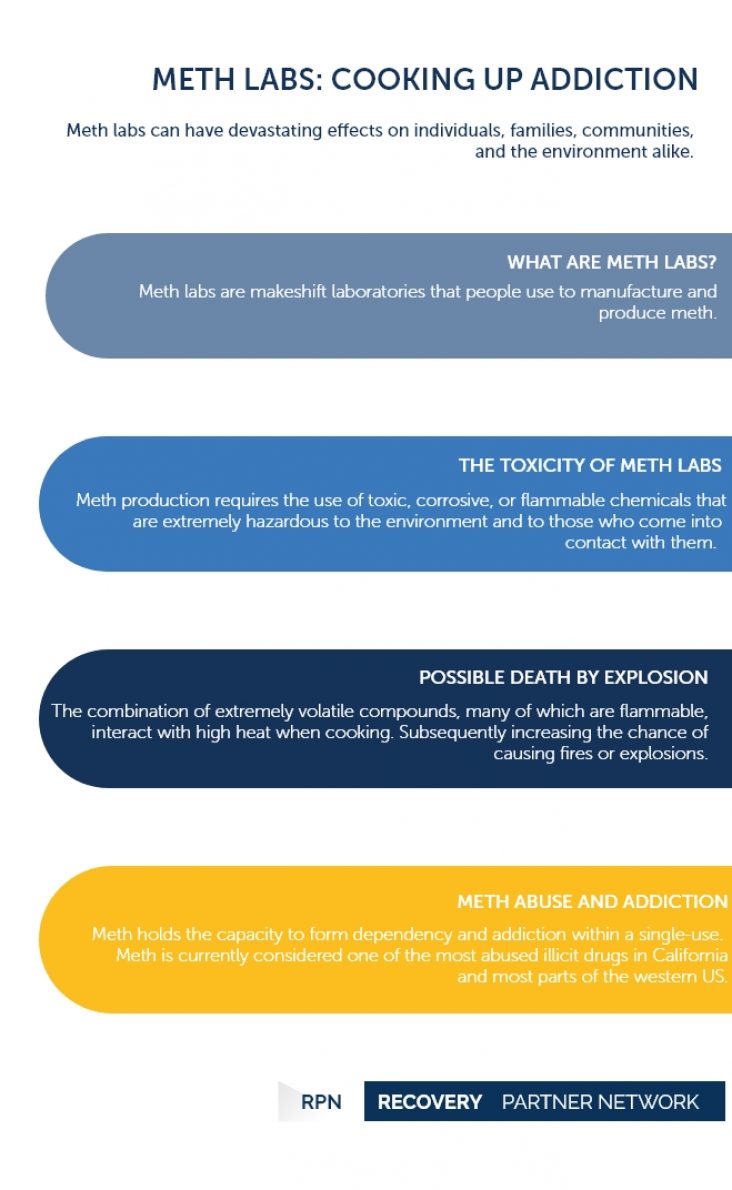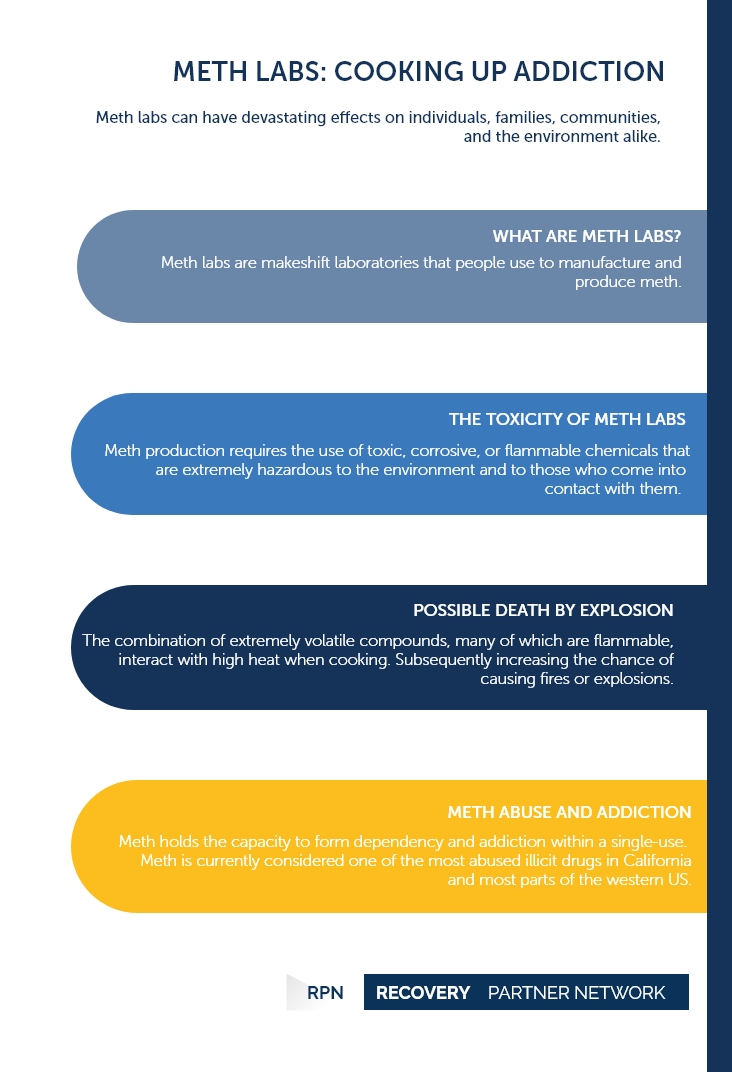Meth labs can have devastating effects on individuals, families, communities, and the environment alike.
Meth Labs: Cooking up Addiction
Illicit drugs
- Ayahuasca addiction – Abuse
- Baclofen addiction
- Black tar heroin addiction
- Cannabis addiction
- Cocaine dependence
- Crack cocaine addiction
- DMT addiction abuse treatment
- Does Marijuana Kill Brain Cells?
- Ecstasy addiction
- Gabapentin addiction
- gamma-Hydroxybutyric acid addiction
- Hallucinogen
- Heroin addiction
- Illicit drug addiction
- Inhalant addiction
- Cocaine
- Ketamine addiction
- Lysergic acid diethylamide addiction
- Mescaline addiction
- Methamphetamine addiction
- Meth Labs: Cooking up Addiction
- Meth Mouth
- Microdosing
- Phencyclidine addiction
- Psilocybin mushroom addiction
- Sage of the diviners – Addiction
- Shooting Heroin
- Shooting Methamphetamine
- Smoking Cannabis
- Speedball
- Synthetic cannabinoids
Meth Labs: Cooking up Addiction | Table of Contents
What Are Meth Labs?
Meth labs are makeshift laboratories that people use to manufacture and produce meth. These facilities, mostly found in the Midwest, are rising to meet the escalating need for meth at alarming rates. Methamphetamine abuse is rising among many American states. Statistics show that 440,000 people used methamphetamine regularly in previous years. According to the Centers for Disease Control and Prevention (CDC), nearly 6,000 people died from stimulant use, mainly meth, in 2015, which is approximately a 255 percent increase from 2005.
The demand for methamphetamine or “meth” has led many towards the production and manufacture of this illicit substance in makeshift labs at their homes and vehicles. Many individuals cook meth not only for their own consumption but also for making a profit and fueling their addiction.
Missouri is estimated to have the largest number of meth laboratories, considering the fact that 1,825 meth laboratories were found in a single year. It is then closely followed by Tennessee, with the discovery of 1,585 meth labs in a single year. These laboratories can be located in apartments, houses, sheds, hotels, while some also use their vehicles as meth labs. Meth laboratories are sometimes located in woodlands and other remote locations due to the appeal of seclusion.
FAQ
Signs of someone conducting an illegal drug may include a combination of events such as strong chemical odor, unusual security systems at the premises, increased activity at night, unusual structure, windows covered with plastic or tin foil, and discoloration of structures, pavement, and soil.
If you suspect meth lab activity in your neighborhood, immediately notify your local authority and do not enter the premises.
The Toxicity of Meth Labs
Meth can be produced from household items, such as pseudoephedrine that is found in OTC medications (over-the-counter). However, authorities quickly caught onto individuals misusing pseudoephedrine, as a vast number of medications containing the drug, such as Sudafed, were purchased or stolen. Consequently, such drugs are now only sold behind the counter with strict restrictions on limited pills per person. Other easy to access ingredients such as antifreeze, iodine, and kitty litter make meth easy to produce, but extremely toxic.
Since meth production requires the use of toxic, corrosive, or flammable chemicals, the vapors created during these chemical reactions directly harm the mucous membranes of the skin, eyes, and respiratory tract of anyone nearby. Some of these chemicals respond dangerously to water, while some can easily erupt into flames or explosions.
Hazards of meth exposure may include:
- Nausea and vomiting
- Burns and skin irritations
- Dizziness
- Eye irritation
- Environmental pollution
- Cardiovascular, respiratory, and neurological failure
- Memory loss
- Depression
- Development of epilepsy and pneumonia
Meth production creates hazardous sludge, such as battery acid and harmful contaminants that pollute the environment. These toxins are so harmful that they can cause disfigurement, or even death during direct contact. For each pound of meth made, individuals dump 5 to 7 pounds of liquid waste containing corrosive liquids, acid vapors, heavy metals, solvents, and other harmful materials. The waste and ingredients are sometimes left behind on the grounds, exposing the earth and surrounding ecosystem to radioactive chemicals.
Meth labs can severely damage buildings and the surrounding area for many years after shutting down. Former meth labs have to be exhaustively cleaned before they are fit for use, while some buildings can be deemed permanently unsafe and demolished. Toxins contaminate many parts of the building, persisting well after the meth lab vacates the premises. Such contamination usually results in short-term health effects that require hospitalization, depending on how long the individual lived in the contaminated household. During drug busts within such premises, police sometimes experience headaches, nose bleeds, mouth sores, and breathing difficulties due to the harsh chemical compounds found in meth even after a short period of exposure.
FAQ
The most common chemicals used to make meth are over-the-counter cold and asthma medications that contain ephedrine or pseudoephedrine.
Health effects caused by exposure to the chemicals and fumes produced by meth labs include shortness of breath, cough, chest pain, dizziness, lack of coordination, chemical irritation, burns to the skin, eyes, nose, and mouth, and in severe cases, even death.
Second-Hand Toxic Exposure to Children
Children can also be equally affected by the harmful chemicals produced by meth labs when their parents are involved in such illegal activity. Children at these homes are particularly vulnerable to respiratory infection during their early stages of development. For example, children may unknowingly put contaminated toys in their mouths or play on contaminated house carpets.
Many other household items, including sofas, baby bottles, clothing, curtains, and drapes, absorb vaporized chemicals that are created from meth use or production. Even the hair of a child’s mother holds toxic chemicals that can be inhaled by the child. Such children are also at risk of coming into contact with used needles that are improperly disposed of. Many of the children found at these homes suffer serious child abuse and neglect. According to a report in 2004, there have been around 3,000 children removed by authorities from premises containing meth labs in the US. However, these numbers are suspected to be much higher, as most states do not keep such records.
Health risks faced by children growing up around meth may include:
- Brain damage
- Increased risk of stroke
- Rapid facial aging
- Kidney damage
- Heart damage
- Increased risk of HIV and hepatitis
- Skin sores and infection
- Delay or decrease in cognitive development
- Insomnia
- Anxiety
- Aggression and mood disorders
- Psychotic behavior
- Chronic health issues
- Increased risk of developing cancer
Unfortunately, meth labs often store meth chemicals in 2-liter soft drink bottles, which are quite often mistaken by small children for soft drinks. This has resulted in a high number of fatalities among very young children.
Possible Death by Explosion
Explosions and fires are common occurrences, whether they are home-labs or vehicular-labs. The combination of extremely toxic compounds, many of which are flammable, interact with high heat when cooking. Subsequently increasing the chance of causing fires or explosions. The “shake and bake method” particularly increases the risk of an explosion due to the build-up of pressure within the plastic bottle. The end result may harm or kill individuals in the vicinity. Individuals who have escaped these explosions or fires have sometimes lost limbs or suffered severe scarring due to burns.
Meth Abuse and Addiction
Meth, also known as crystal meth, is a highly addictive psychoactive stimulant that can induce a euphoric high, closely followed by an intense crash that causes depression, paranoia, and aggression. This drug is available in the form of crystals or an odorless white powder that can be smoked, snorted, swallowed, or injected. Meth holds the capacity to form dependency and addiction within a single-use. Due to its wide availability and low pricing, most addicts find themselves lured to its use. Meth is currently considered as one of the most abused illicit drugs in California and most parts of the western US.
Recovery Partner Network
We aim to educate and empower. If you feel our library of resources does not cover your specific need, reach out to us, and we would be happy to help.
STATISTICS
© Copyright 2025


